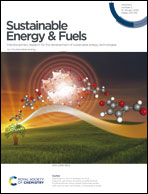Electrolyte engineering on a porphyrin-based electrode for lithium–organic charge storage†
Abstract
Lithium–organic batteries using organic molecules as active materials have attracted considerable attention. However, the dissolution of organic active materials and mismatched electrolyte have led to insufficient cycle life. The electrolyte chemistry induced stable solid-electrolyte interface at the electrode plays a critical role in the improvement of electrochemical performance. Herein, electrolyte engineering with different anions on a porphyrin-based cathode was systematically studied. The cycling stability and reversible capacity of the functionalized porphyrin of [5,15-bis(ethynyl)-10,20-diphenylporphinato]copper(II) (CuDEPP) were significantly influenced by regulating electrolytes. The CuDEPP cathode exhibited better compatibility with electrolyte containing phosphorus and nitrogen-based anions than boron-based ones. Anions containing C![[double bond, length as m-dash]](https://www.rsc.org/images/entities/char_e001.gif) O or S
O or S![[double bond, length as m-dash]](https://www.rsc.org/images/entities/char_e001.gif) O groups showed enhanced charge storage performance. Improved specific capacity (up to 250 mA h g−1) was achieved in lithium bis(trifluoromethanesulfonyl)imide (LiTFSI) based electrolyte. Different techniques were applied to probe the porphyrin cathode and it was revealed that electrolytes with appropriate functionalized groups and higher concentration can improve the charge storage performance of the porphyrin cathode in lithium–organic batteries.
O groups showed enhanced charge storage performance. Improved specific capacity (up to 250 mA h g−1) was achieved in lithium bis(trifluoromethanesulfonyl)imide (LiTFSI) based electrolyte. Different techniques were applied to probe the porphyrin cathode and it was revealed that electrolytes with appropriate functionalized groups and higher concentration can improve the charge storage performance of the porphyrin cathode in lithium–organic batteries.



 Please wait while we load your content...
Please wait while we load your content...